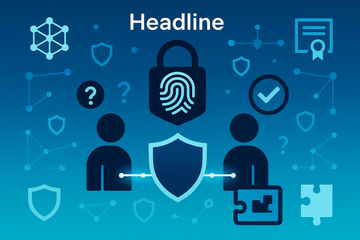Ever tried to guess the ending of a movie and felt pretty smug if you got it right, but couldn’t prove you weren’t just bluffing? What if you could convince your skeptical friend you really knew it, without spoiling a thing? Believe it or not, this exact puzzle sits at the heart of cryptographic security, and it’s got a name: Proof of Knowledge, or PoK if you’re feeling fancy.
So, What’s Proof of Knowledge Anyway?
Let’s put it plainly. Proof of Knowledge is a protocol—a set of agreed rules—between two parties: one is the prover (the person who claims to know something), and the other is the verifier (the person who needs to be convinced the claim is legit). But here’s the catch: the prover has to demonstrate they know what they say they know, without actually revealing the information itself (Ledger Academy).
It sounds slick, right? Like a magic trick or a clever riddle. It’s all about trust, but done in a way where trust isn’t just given—it’s cryptographically earned, brick by brick.
How’s That Supposed to Work?
It’s one thing to say, “Trust me, bro,” but in the cryptocurrency world, we’ve all seen how well empty promises go. So, PoK sets up a structure called challenge-response—a bit like a secret handshake:
- Request: The verifier asks for proof—like asking a coder friend, 'Can you show you really know Python?'
- Challenge: The verifier creates a puzzle or riddle only someone with the knowledge could solve (think of it like picking out 'the real fan' of a movie by asking for a tiny but critical plot detail).
- Response: The prover answers the challenge, never exposing the core secret but proving they have access to it.
- Verification: The verifier checks the answer, confirming the knowledge without ever seeing the secret itself (Bittime).
Smart, right? It’s the digital equivalent of someone saying, “I know the secret recipe, but I won’t tell you the whole list. Here’s a taste—you’ll see I’ve got it.”
A Day in the Life: Real-World PoK in Action
Crypto Hardware Wallets: Where Knowledge IS Power
Let’s get concrete. Consider Trezor or Ledger hardware wallets—those compact gadgets so many use to stash their crypto safely. When you set up a Ledger wallet, for example, it generates a recovery phrase only you know. When the time comes to prove you still have your keys (say, recovering access), the wallet doesn’t force you to transmit your entire phrase, exposing yourself to network snoops. Instead, it requests snips or proofs—think of it as, “Prove you know the secret, without blurting it out.” That’s PoK, keeping your secrets sealed (Ledger Academy).
Zero-Knowledge Proofs: Privacy on the Blockchain
Here’s another twist: imagine posting on a basketball forum, and you want to show you’re a true Mavericks fan for access to a secret channel, but you don’t want to share your real name. Zero-knowledge proofs (fancy cousins of PoK) let you prove your fandom (“I own an NFT of a Mavericks jersey!”) without showing your wallet, identity, or the NFT details. Projects like Zcash built their privacy models on zero-knowledge proofs—PoK’s showing off their cryptographic dance moves.
It’s Not Just Crypto—Education Gets a Makeover
Let me explain. While blockchain uses PoK for security, other industries are catching on. The education world’s latest trend is verifiable digital credentials. Universities and online academies began issuing diplomas as NFTs or blockchain tokens. When someone asks you for proof of your degree—maybe a snoopy HR manager—you prove you own the digital certificate, but you don’t have to hand over the full parchment (and your GPA, and that embarrassing barely-pass grade in statistics). Bittopia dishes out NFT microcredentials, handing you control, privacy, and just enough information to convince—but never overshare (Bittopia University).
Why Should Anyone Bother?
You might wonder if this is just tech for tech’s sake. It’s not. Think about the growing pressure for data privacy. With leaks in every headline, no one wants their banking details, passwords, or college transcripts floating loose. PoK locks down that risk by never giving up the core info during verification—just proof that you’ve got the goods.
And let’s be real—crypto, while fun, can be a wild ride. Hacks, phishing attacks, fake websites—it pays to have protocols making sure nobody nabs your seed phrase or wallet access, even by accident. It’s about stacking odds in your favor, not against you.
But It’s Not Perfect—Here’s the Catch
Now, as promising as PoK sounds, it’s not a catch-all shield. Yes, it keeps your secrets safer, but the protocol relies on properly designed cryptographic puzzles. If a company, wallet, or school gets lazy about implementation, the jig is up. And hey, while PoK can prove you know something, it can’t un-do a slip-up where you accidentally blurt out your private key in a tipsy Twitter post (we all know someone...)
So, What’s Next?
With privacy worries climbing, from corporate breaches to personal snooping, Proof of Knowledge isn’t just a nerdy concept—it’s woven into your daily digital life. There’s a quiet confidence in knowing you can prove yourself without giving everything away. Whether you’re locking down your crypto with that Trezor, showing off your bona fides on a job board, or sending a secret message to your best friend, you’re relying on the kind of smarts that says, “Trust, but verify. Carefully.”
Honestly, isn’t that the kind of world we want? Where you can stand behind what you know, yet keep your secrets your own? That’s the quiet power of Proof of Knowledge—and it’s only getting started.











